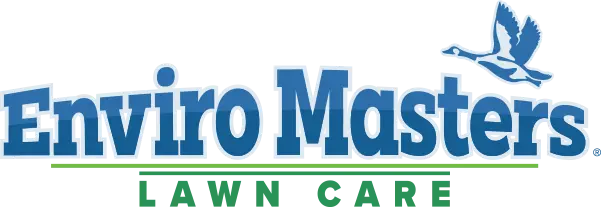Lawn Disease Identification
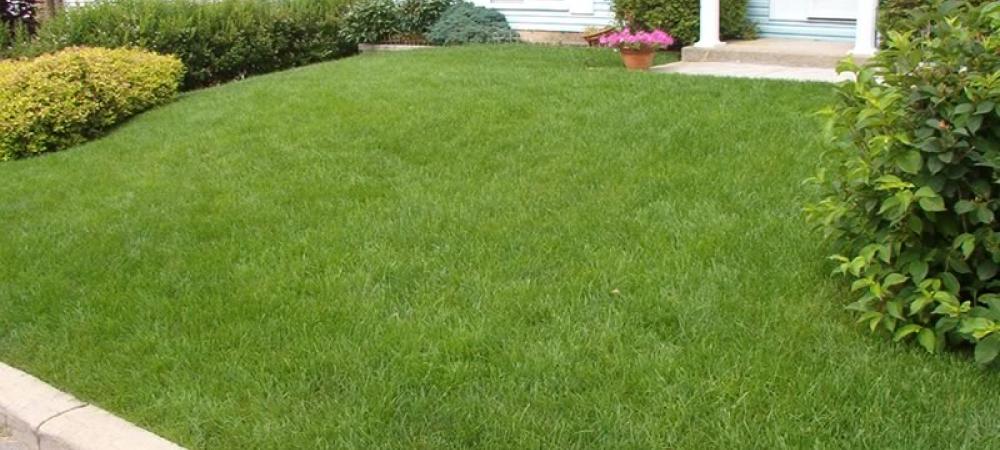
Maintaining a lush, green lawn requires more than regular watering and mowing. Lawn diseases can pose a significant threat to its health and aesthetics. In this blog, we'll delve into the identification of various common lawn diseases, including:
Snow Mold
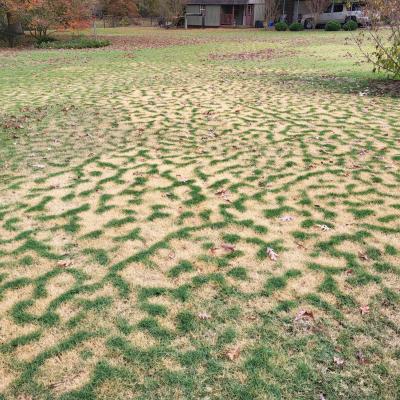
Snow Mold is a disease that develops under snow cover during the winter months. It is first evident in the spring after the snow cover melts. It affects all northern grasses, especially perennial ryegrass. The most common types are Pink Snow Mold (Microdochium nivale) and Grey Snow Mold (Typhula incarnate).
- Appearance: The circular patches it forms are typically 4-12 inches in diameter. The pink coloration is a result of the fungal mycelium-producing pigments, while the grey coloration can be attributed to Typhula blight.
- Contributing Factors: The conditions favoring the disease are lush growth in the previous fall, extended periods of snow cover, soil temperatures of -1 to -4 degrees Celsius below the snow cover, and high moisture content.
- Susceptible Areas: Lawns with heavy thatch, poor drainage, or areas where snow persists for an extended period.
- Most Active: Late winter or early spring after snowmelt.
- How To Control: Proper lawn aeration, improving air circulation, avoiding excessive thatch buildup, and applying fungicides with active ingredients like, thiophanate-methyl and chlorothalonil, can effectively manage Snow Mold.
- Best Time for Control: Early spring before new growth begins.
Red Thread
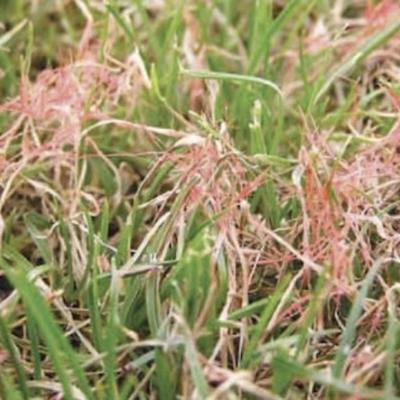
Red Thread (Laetisaria fuciformis) is a disease that can occur in the spring and fall when there is plenty of moisture, and the grass is actively growing. It affects all northern grasses, especially perennial ryegrass, and fine fescue.
- Appearance: It will appear as diffuse, irregular patches from 5-35 cm with pinkish-red strands developing on individual leaves.
- Contributing Factors: The conditions favoring the disease are nitrogen deficiencies in the soil, air temperatures between 15 to 25 degrees Celsius, and high moisture content. The red or pink threads on grass blades are structures of the fungus that can reach up to an inch in length.
- Susceptible Areas: Lawns with poor soil fertility, inadequate nitrogen levels, and areas with limited airflow.
- Most Active: Spring and fall, especially in cool, humid conditions.
- How To Control: To address Red Thread, it's essential to enhance nitrogen levels through fertilization and ensure proper lawn drainage to reduce humidity.
- Best Time for Control: Late spring or early summer; apply fungicides and address nutrient deficiencies.
Necrotic Ring Spot
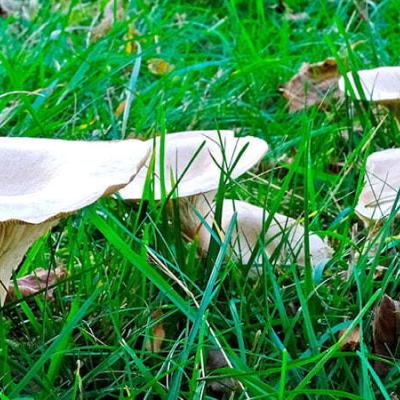
Necrotic Ring Spot (Leptosphaeria korrae) results in rings of dead grass surrounded by healthy grass. It is the most serious home lawn disease because it targets Kentucky bluegrass (the most common grass) and fine fescues. The fungus affects the roots 12 to 18 months before symptoms appear in the grass itself.
- Appearance: Dead rings from 10 cm to 1 m develop that have green centers.
- Contributing Factors: This disease is commonly associated with stress factors such as compacted soil or excessive thatch.
- Susceptible Areas: Lawns with heavy thatch, compacted soil, or areas with poor water drainage.
- Most Active: Late spring to early summer.
- How To Control: To manage Necrotic Ring Spot, implement core aeration, overseeding with disease-resistant grass varieties, and adjusting watering practices.
- Best Time for Control: Late summer or early fall; implement cultural practices like aeration and overseeding.
Powdery Mildew
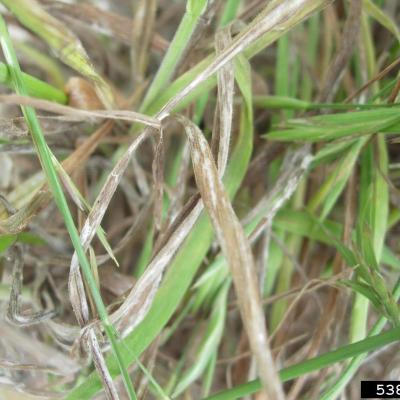
Powdery Mildew (Erysiphe graminis) is caused by various fungi belonging to the Erysiphaceae family. The disease commonly develops in shaded areas of lawns, often between houses, under trees, and on the north side of properties. It affects all northern grasses especially Kentucky bluegrass.
- Appearance: It forms a dull, white, powdery substance on grass blades, inhibiting photosynthesis.
- Contributing Factors: Conditions favoring the disease are humid or wet areas in the shade, with poor air circulation and temperatures between 15 and 20 degrees Celsius.
- Susceptible Areas: Lawns with limited sunlight, poor air circulation, and areas prone to drought stress.
- Most Active: Late spring to early fall in dry conditions.
- How To Control: Improving air circulation, reducing shade, and applying fungicides containing active ingredients like sulfur or potassium bicarbonate can effectively control Powdery Mildew.
- Best Time for Control: Spring or early summer; improve air circulation and apply fungicides preventatively.
Leaf Spot
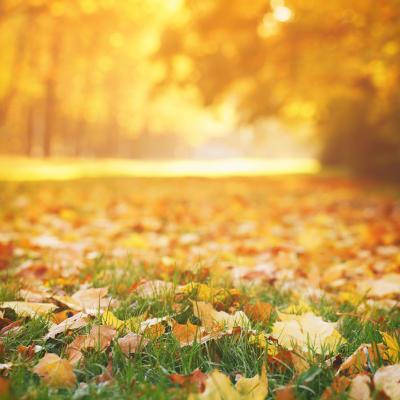
Helminthosporium Leaf Spot (Drechslera Spp.) is a disease that develops in the cool, moist conditions of spring and fall. It affects all northern grasses especially Kentucky bluegrass.
- Appearance: Leaf Spot results in small, elliptical lesions on grass blades. The lesions have dark borders and bleached centers often with a yellowish halo around the lesion.These lesions can coalesce, leading to yellowing and thinning of the lawn.
- Contributing Factors: Conditions favoring the disease are excess fertility, mowing height of less than 1 inch, leaf wetness for greater than 10 hours and temperatures between 3 and 27 degrees Celsius.
- Susceptible Areas: Lawns with high humidity levels, frequent rainfall, and areas where mowing height is too low.
- Most Active: Spring and fall in humid conditions.
- How To Control: Proper mowing practices, such as maintaining a higher mowing height, and applying fungicides with active ingredients like azoxystrobin can help manage Leaf Spot.
- Best Time for Control: Spring and early summer; adjust mowing height, improve air circulation, and apply fungicides if necessary.
Lawn Rust
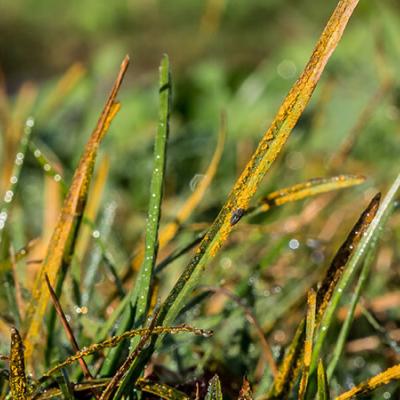
Rusts (Puccinia Spp.) is a disease that generally shows up in late August or early September. It affects all northern grasses, especially Kentucky bluegrass and perennial ryegrass. It is unusual in that it requires an alternate host to develop.
- Appearance: Lawn Rust produces orange or rust-colored pustules on grass blades. Severe infestations can weaken the grass and hinder its growth.
- Contributing Factors: Conditions favoring the disease are low light and 22-25 degree temperatures for infection and high light and 26-35 degree temperatures for disease growth.
- Susceptible Areas: Lawns in warm climates, areas with poor air circulation, and lawns with high nitrogen levels.
- Most Active: Late spring to early fall in warm and humid conditions.
- How To Control: To control Rusts, practice proper irrigation, avoid excessive nitrogen fertilization, and apply fungicides with active ingredients like propiconazole.
- Best Time for Control: Spring and early summer; manage with proper watering and fungicidal treatments.
Fairy Ring
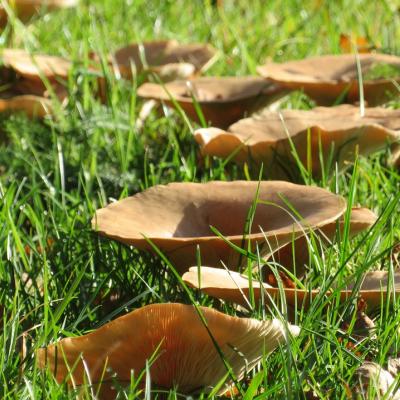
Fairy Ring (Marasmius oreades) is caused by various soil-inhabiting fungi, such as Basidiomycetes. There are 3 common varieties of this disease. These are a mushroom ring, a killing ring, and a stimulated ring, with the last being the most common in Ontario. The stimulated ring appears as a circle or crescent of darker green and more rapidly growing turfgrass
- Appearance: It manifests as circular rings of dark green grass, mushrooms, or dead grass. Grass in the inner part of the circle grows more slowly because of the presence of a mass of white mycelium. These circles range from a few centimeters to a few meters in diameter.
- Contributing Factors: Fairy rings thrive in lawns with high organic matter, significant thatch accumulation, and consistently moist but not waterlogged soil. Warmer temperatures, dense thatch, and excessive nitrogen fertilization contribute to the optimal conditions for fairy ring development.
- Susceptible Areas: Lawns with heavy thatch, poor soil drainage, and areas with a history of fungal issues.
- Most Active: Late spring to early fall.
- How To Control: Managing Fairy Ring is challenging and may require a combination of cultural practices like aeration, dethatching, and the use of fungicides containing active ingredients like flutolanil.
- Best Time for Control: Spring and early summer; implement cultural practices like aeration and fungicidal treatments.
Dollar Spot
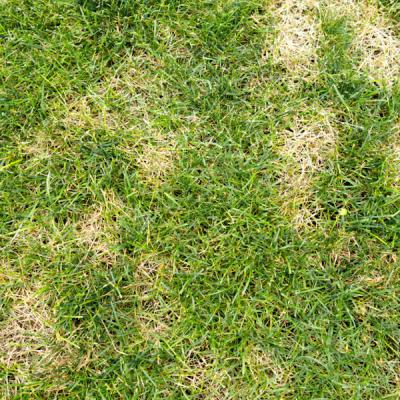
Dollar Spot (Sclerotinia homoeocarpa) can affect all northern grasses but is more common on golf greens than on home lawns. It appears as hourglass lesions on the leaf blade with a bleached area crossing the entire leaf blade surrounded by a brown margin. The mycelium can look like cobwebs on the grass in the early morning.
- Appearance: Dollar Spot leads to small, silver-dollar-sized patches of bleached or dead grass.
- Contributing Factors: Conditions favoring the disease are grasses low in nitrogen content, excess thatch, extended leaf wetness, and temperatures in the 21-27 degree Celsius range.
- Susceptible Areas: Lawns with insufficient nitrogen levels, areas with poor air circulation, and lawns in warm and humid regions.
- Most Active: Late spring to early fall in warm and humid conditions.
- How To Control: To control Dollar Spot, maintain proper nitrogen levels through fertilization and apply fungicides with active ingredients like propiconazole or thiophanate-methyl.
- Best Time for Control: Spring and early summer; address nutrient deficiencies, improve air circulation, and apply fungicides if necessary.
How To Manage Lawn Diseases
Regular inspection and timely identification of lawn diseases are crucial for maintaining a healthy and vibrant lawn. If you are looking for effective lawn treatments that manage a variety of common fungal diseases, look no further than Enviro Masters Lawn Care. Our teams of experienced technicians are here to give your lawn the care it needs to thrive! Contact us today.
